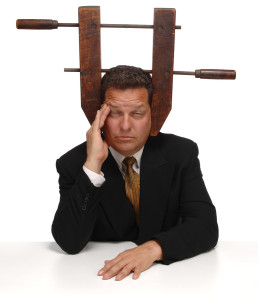Introduction
A tension type headache is among the most common among all of the headaches.
These headaches occur in up to 80 % of the population in a lifetime. Often patients suffer from them already in their teenage years. Their frequency decreases with age in both sexes. Genetic and socioeconomic factors do not seem to play a role.
The mechanism of tension type headaches is not entirely understood, but seems to be a combination of three factors, namely muscle tension, neck muscle pain and pain in the temples, receptor stimulation in the brain stem from nerve connections to blood vessels and a contribution of the brain from emotional tensions, which seems to modulate the severity of the headache. In every patient the percentage of each of these factors can be different, which needs to be taken into account when treating a person with a tension type headache (Ref. 1, p. 2069).
Symptoms
Tension type headaches are felt on both sides in the sense of a tight band around he head. They will last minutes in one person, but days in another, if they are more severe. They are not aggravated by physical activity. Nausea is not present, but sensitivity to light and sensitivity to noise can make them worse. There are different forms of this type of headache, an episodic form and a chronic form. In the chronic form there are at least 15 days in one month with tension type headaches, whereas in the episodic form symptoms are more fleeting.
Treatment
For episodic tension type headache simple analgesics are the treatment of choice. There is a wide variety of medications such as acetaminophen, ketoprofen, ibuprofen, naproxen or simple ASA, if this causes no problems for the stomach.
More severe headaches or chronic tension type headaches require low dose antidepressant medication, which works on the modulation aspect of the tension type headache. Amitriptyline at a starting dose only 10 mg is usually the drug of choice, but other antidepressants such as fluoxetine, doxepin and trazodone are alternatives that can be used. If a patient uses more than three days worth of pain pills per week on average (particularly narcotics), drug dependency becomes an issue. The patient would benefit from an assessment by a neurologist.
References:
1. Goldman: Cecil Textbook of Medicine, 21st ed.,2000, W. B. Saunders Company
2. B. Sears: “The top 100 zone foods”. Regan Books, Harper Collins, 2001.
3. The Merck Manual, 7th edition, by M. H. Beers et al., Whitehouse Station, N.J., 1999. Chapter 176.
4. Noble: Textbook of Primary Care Medicine, 3rd ed.,2001, Mosby, Inc.
5. Goroll: Primary Care Medicine, 4th ed.,2000, Lippincott Williams & Wilkins
6.Rosen: Emergency Medicine: Concepts and Clinical Practice, 4th ed., 1998, Mosby-Year Book, Inc.
7. Ruddy: Kelley’s Textbook of Rheumatology, 6th ed.,2001, W. B. Saunders Company
8. Ferri: Ferri’s Clinical Advisor: Instant Diagnosis and Treatment, 2004 ed., Copyright © 2004 Mosby, Inc.
9. Rakel: Conn’s Current Therapy 2004, 56th ed., Copyright © 2004 Elsevier
10. Suzanne Somers: “Breakthrough” Eight Steps to Wellness– Life-altering Secrets from Today’s Cutting-edge Doctors”, Crown Publishers, 2008







